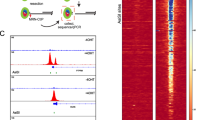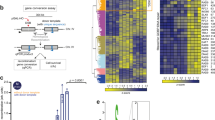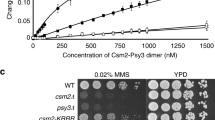Abstract
DNA ends exposed after introduction of double-strand breaks (DSBs) undergo 5′–3′ nucleolytic degradation to generate single-stranded DNA, the substrate for binding by the Rad51 protein to initiate homologous recombination. This process is poorly understood in eukaryotes, but several factors have been implicated, including the Mre11 complex (Mre11–Rad50–Xrs2/NBS1), Sae2/CtIP/Ctp1 and Exo1. Here we demonstrate that yeast Exo1 nuclease and Sgs1 helicase function in alternative pathways for DSB processing. Novel, partially resected intermediates accumulate in a double mutant lacking Exo1 and Sgs1, which are poor substrates for homologous recombination. The early processing step that generates partly resected intermediates is dependent on Sae2. When Sae2 is absent, in addition to Exo1 and Sgs1, unprocessed DSBs accumulate and homology-dependent repair fails. These results suggest a two-step mechanism for DSB processing during homologous recombination. First, the Mre11 complex and Sae2 remove a small oligonucleotide(s) from the DNA ends to form an early intermediate. Second, Exo1 and/or Sgs1 rapidly process this intermediate to generate extensive tracts of single-stranded DNA that serve as substrate for Rad51.
This is a preview of subscription content, access via your institution
Access options
Subscribe to this journal
Receive 51 print issues and online access
$199.00 per year
only $3.90 per issue
Buy this article
- Purchase on Springer Link
- Instant access to full article PDF
Prices may be subject to local taxes which are calculated during checkout





Similar content being viewed by others
References
Lee, S. E. et al. Saccharomyces Ku70, mre11/rad50 and RPA proteins regulate adaptation to G2/M arrest after DNA damage. Cell 94, 399–409 (1998)
Lisby, M., Barlow, J. H., Burgess, R. C. & Rothstein, R. Choreography of the DNA damage response: spatiotemporal relationships among checkpoint and repair proteins. Cell 118, 699–713 (2004)
Nelms, B. E., Maser, R. S., MacKay, J. F., Lagally, M. G. & Petrini, J. H. In situ visualization of DNA double-strand break repair in human fibroblasts. Science 280, 590–592 (1998)
Krogh, B. O. & Symington, L. S. Recombination proteins in yeast. Annu. Rev. Genet. 38, 233–271 (2004)
Llorente, B. & Symington, L. S. The Mre11 nuclease is not required for 5′ to 3′ resection at multiple HO-induced double-strand breaks. Mol. Cell. Biol. 24, 9682–9694 (2004)
Lobachev, K. S., Gordenin, D. A. & Resnick, M. A. The Mre11 complex is required for repair of hairpin-capped double-strand breaks and prevention of chromosome rearrangements. Cell 108, 183–193 (2002)
Rattray, A. J., McGill, C. B., Shafer, B. K. & Strathern, J. N. Fidelity of mitotic double-strand-break repair in Saccharomyces cerevisiae: a role for SAE2/COM1 . Genetics 158, 109–122 (2001)
Clerici, M., Mantiero, D., Lucchini, G. & Longhese, M. P. The Saccharomyces cerevisiae Sae2 protein promotes resection and bridging of double strand break ends. J. Biol. Chem. 280, 38631–38638 (2005)
Limbo, O. et al. Ctp1 is a cell-cycle-regulated protein that functions with Mre11 complex to control double-strand break repair by homologous recombination. Mol. Cell 28, 134–146 (2007)
Sartori, A. A. et al. Human CtIP promotes DNA end resection. Nature 450, 509–514 (2007)
Tran, P. T., Erdeniz, N., Symington, L. S. & Liskay, R. M. EXO1-A multi-tasking eukaryotic nuclease. DNA Repair (Amst.) 3, 1549–1559 (2004)
Clerici, M., Mantiero, D., Lucchini, G. & Longhese, M. P. The Saccharomyces cerevisiae Sae2 protein negatively regulates DNA damage checkpoint signalling. EMBO Rep. 7, 212–218 (2006)
Hickson, I. D. RecQ helicases: caretakers of the genome. Nature Rev. Cancer 3, 169–178 (2003)
Vaze, M. B. et al. Recovery from checkpoint-mediated arrest after repair of a double-strand break requires Srs2 helicase. Mol. Cell 10, 373–385 (2002)
Mozlin, A. M., Fung, C. W. & Symington, L. S. Role of the Saccharomyces cerevisiae Rad51 paralogs in sister chromatid recombination. Genetics 178, 113–126 (2008)
Ivanov, E. L., Sugawara, N., Fishman-Lobell, J. & Haber, J. E. Genetic requirements for the single-strand annealing pathway of double-strand break repair in Saccharomyces cerevisiae . Genetics 142, 693–704 (1996)
Amundsen, S. K. & Smith, G. R. Interchangeable parts of the Escherichia coli recombination machinery. Cell 112, 741–744 (2003)
Gangloff, S., McDonald, J. P., Bendixen, C., Arthur, L. & Rothstein, R. The yeast type I topoisomerase Top3 interacts with Sgs1, a DNA helicase homolog: a potential eukaryotic reverse gyrase. Mol. Cell. Biol. 14, 8391–8398 (1994)
Watt, P. M., Louis, E. J., Borts, R. H. & Hickson, I. D. Sgs1: a eukaryotic homolog of E. coli RecQ that interacts with topoisomerase II in vivo and is required for faithful chromosome segregation. Cell 81, 253–260 (1995)
Pan, X. et al. A DNA integrity network in the yeast Saccharomyces cerevisiae . Cell 124, 1069–1081 (2006)
White, C. I. & Haber, J. E. Intermediates of recombination during mating type switching in Saccharomyces cerevisiae . EMBO J. 9, 663–673 (1990)
Mullen, J. R., Kaliraman, V. & Brill, S. J. Bipartite structure of the SGS1 DNA helicase in Saccharomyces cerevisiae . Genetics 154, 1101–1114 (2000)
Jazayeri, A., Balestrini, A., Garner, E., Haber, J. E. & Costanzo, V. Mre11-Rad50-Nbs1-dependent processing of DNA breaks generates oligonucleotides that stimulate ATM activity. EMBO J. 27, 1953–1962 (2008)
Lengsfeld, B. M., Rattray, A. J., Bhaskara, V., Ghirlando, R. & Paull, T. T. Sae2 is an endonuclease that processes hairpin DNA cooperatively with the Mre11/Rad50/Xrs2 complex. Mol. Cell 28, 638–651 (2007)
Baron, U. & Bujard, H. Tet repressor-based system for regulated gene expression in eukaryotic cells: principles and advances. Methods Enzymol. 327, 401–421 (2000)
Bennett, R. J., Keck, J. L. & Wang, J. C. Binding specificity determines polarity of DNA unwinding by the Sgs1 protein of S. cerevisiae . J. Mol. Biol. 289, 235–248 (1999)
Budd, M. E. et al. A network of multi-tasking proteins at the DNA replication fork preserves genome stability. PLoS Genet 1, e61 (2005)
Gangloff, S., Soustelle, C. & Fabre, F. Homologous recombination is responsible for cell death in the absence of the Sgs1 and Srs2 helicases. Nature Genet. 25, 192–194 (2000)
van Brabant, A. J. et al. Binding and melting of D-loops by the Bloom syndrome helicase. Biochemistry 39, 14617–14625 (2000)
Wu, L. & Hickson, I. D. The Bloom’s syndrome helicase suppresses crossing over during homologous recombination. Nature 426, 870–874 (2003)
Karmakar, P. et al. BLM is an early responder to DNA double-strand breaks. Biochem. Biophys. Res. Commun. 348, 62–69 (2006)
Zou, H. & Rothstein, R. Holliday junctions accumulate in replication mutants via a RecA homolog-independent mechanism. Cell 90, 87–96 (1997)
Borde, V., Wu, T. C. & Lichten, M. Use of a recombination reporter insert to define meiotic recombination domains on chromosome III of Saccharomyces cerevisiae . Mol. Cell. Biol. 19, 4832–4842 (1999)
Goldstein, A. L. & McCusker, J. H. Three new dominant drug resistance cassettes for gene disruption in Saccharomyces cerevisiae . Yeast 15, 1541–1553 (1999)
Longtine, M. S. et al. Additional modules for versatile and economical PCR-based gene deletion and modification in Saccharomyces cerevisiae . Yeast 14, 953–961 (1998)
Sherman, F., Fink, G. & Hicks, J. Methods in Yeast Genetics (Cold Spring Harbor Laboratory, 1986)
Nickoloff, J. A., Singer, J. D., Hoekstra, M. F. & Heffron, F. Double-strand breaks stimulate alternative mechanisms of recombination repair. J. Mol. Biol. 207, 527–541 (1989)
Acknowledgements
We thank M. Lichten, J. McCusker, A. Rattray and R. Rothstein for gifts of strains and plasmids, and W. K. Holloman and R. Rothstein for comments on the manuscript. This study was supported by a grant from the National Institutes of Health.
Author Contributions E.P.M. and L.S.S. designed the experiments and wrote the paper; E.P.M. performed the experiments.
Author information
Authors and Affiliations
Corresponding author
Supplementary information
Supplementary Information
This file contains Supplementary Figures S1-S5 with legends and Supplementary Table with References. (PDF 1662 kb)
Rights and permissions
About this article
Cite this article
Mimitou, E., Symington, L. Sae2, Exo1 and Sgs1 collaborate in DNA double-strand break processing. Nature 455, 770–774 (2008). https://doi.org/10.1038/nature07312
Received:
Accepted:
Published:
Issue Date:
DOI: https://doi.org/10.1038/nature07312
This article is cited by
-
Mre11-Rad50 oligomerization promotes DNA double-strand break repair
Nature Communications (2022)
-
Maximized quantitative phosphoproteomics allows high confidence dissection of the DNA damage signaling network
Scientific Reports (2020)
-
ATM and PRDM9 regulate SPO11-bound recombination intermediates during meiosis
Nature Communications (2020)
-
Sgs1 helicase is required for efficient PCNA monoubiquitination and translesion DNA synthesis in Saccharomyces cerevisiae
Current Genetics (2018)
-
The Sulfolobus solfataricus RecQ-like DNA helicase Hel112 inhibits the NurA/HerA complex exonuclease activity
Extremophiles (2018)
Comments
By submitting a comment you agree to abide by our Terms and Community Guidelines. If you find something abusive or that does not comply with our terms or guidelines please flag it as inappropriate.



